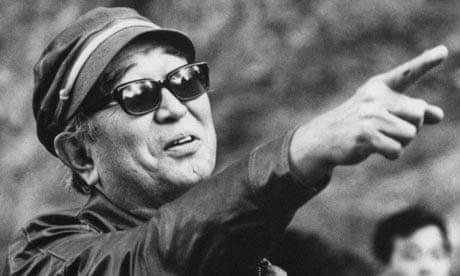1) Drunken Angel (1948)
The youngest of eight children, Akira Kurosawa grew up in Tokyo where, at the age of 26, he began an apprenticeship at PCL studios. His first features as director, made in wartime, had nationalistic strains but No Regrets for Our Youth (1946) and Drunken Angel, about an alcoholic Tokyo doctor trying to get a stagnant pool drained, established a critical engagement with contemporary Japan.
2) Stray Dog (1949)
Drunken Angel inaugurated Kurosawa's working relationship with the actor Toshiro Mifune, which was repeated in this picture, with Mifune playing a policeman on an increasingly obsessive quest to retrieve his stolen gun. Set during a sweltering summer, Kurosawa's breakthrough film confirmed both his feel for contemporary Tokyo and his admiration of American genre pictures.
3) Rashômon (1950)
Recognised at Venice and the Oscars, Rashomon was not just Kurosawa's international breakthrough but the standard-bearer for new Japanese cinema. Recounting a bandit's (Mifune) ambush of a couple in a forest from several contradictory perspectives, its radical challenge to conventional narrative was complemented by beautiful, often stylised photography.
4) The Idiot (1951)
Slashed - to Kurosawa's enduring indignation - from its original length
of more than four hours, The Idiot was an early example of the director's adaptation of European literary sources to a Japanese context. Dostoyevsky's novel is relocated to Hokkaido, with Masayuki Mori as a recently released war criminal and Mifune his temperamental friend.
5) Ikiru (1952)
Centred on the final phase of a middle-aged salaryman's life, Ikiru show Kurosawa in full-blooded humanist mode. Takashi Shimura is the bureaucrat whose diagnosis of terminal cancer initially sends him into alienated despair before he finds a kind of redemption in a project the hero of Drunken Angel might have appreciated.
6) Seven Samurai (1954)
Seven Samurai, about a band of masterless samurai defending a village from bandits, arguably remains Kurosawa's towering cultural achievement. The biggest movie Japan had seen at the time, in terms of budget, production and box-office takings, it was also an enormous influence on Western cinema, as well as enormously influenced by it.
7) Throne of Blood (1957)
Transferring Macbeth to medieval Japan reaps dividends: this is one of the most impressive of all screen adaptations of Shakespeare, streamlining the narrative and expressing it through a series of bravura visual coups. Mifune is the ambitious samurai at the centre of a stark world laced with violence, beauty and irony.
8) The Hidden Fortress (1958)
Another period samurai adventure starring Mifune, The Hidden Fortress was another Kurosawa masterclass in the conflation of Japanese and
Hollywood tropes. The filmmaker's first widescreen effort, its story of a ragtag band trying to transport a princess to safety and eventually help her free her land is the acknowledged source for George Lucas's Star Wars.
9) Yojimbo (1961)
Similarly, Yojimbo drew on film noir and classical Westerns only to
prove massively influential itself, with Sergio Leone taking inspiration from its tale of an effectively nameless lone warrior playing one side of criminals off against another. A funnier, more grotesque sequel, Sanjuro, followed the next year.
10) Ran (1985)
The final decades of Kurosawa's life saw his greatest struggles for artistic freedom, prompting him to look beyond Japan for funding. Shot in colour and influenced by King Lear, Ran, his final grand-scale project, was not without professional and personal cost but confirmed his abilities remained intact.
11) (and one for luck …) Dreams (1990)
One of three more films that followed before his death in 1998, Dreams was an elliptical collection of tales based upon Kurosawa's actual dreams. This is Crow.

Comments (…)
Sign in or create your Guardian account to join the discussion